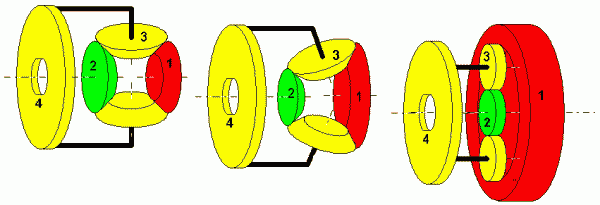 To the left You see a standard differential. If you change the size of the left
and right wheels the axles of the spider wheels must be angled to keep all
wheels in contact, as shown in the middle. Continuing this process will ultimately
give the configuration to the right:
To the left You see a standard differential. If you change the size of the left
and right wheels the axles of the spider wheels must be angled to keep all
wheels in contact, as shown in the middle. Continuing this process will ultimately
give the configuration to the right:
| d1 = d2 + 2 * d3 | |
| (1) | n1 - n2 = 2 * n3 |
| n2 * rot2 + n3 * rot3 = 0 | |
| n3 * rot3 - n1 * rot1 = 0 | |
| (2) | n2 * rot2 + n1 * rot1 = 0 |
| rot1 = - (n2 / n1) * rot2 | |
| rot2 = - (n1 / n2) * rot1 |
| rot4 = -rot1 | |
| rot2 = -(n1 / n2) * rot1 - rot1 | |
| (3) | rot2 = (1 + n1 / n2) * rot4 |
| n2 * rot2 = (n2 + n1) * rot4 |
| rot4 = -rot2 | |
| rot1 = -(n2 / n1) * rot2 - rot2 | |
| (4) | rot1 = (1 + n2 / n1) * rot4 |
| n1 * rot1 = (n1 + n2) * rot4 |
| (5) | n1 * rot1 + n2 * rot2 = (n1 + n2) * rot4 |